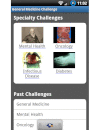The smartphone in medicine: a review of current and potential use among physicians and students
- PMID: 23017375
- PMCID: PMC3510747
- DOI: 10.2196/jmir.1994
The smartphone in medicine: a review of current and potential use among physicians and students
Abstract
Background: Advancements in technology have always had major impacts in medicine. The smartphone is one of the most ubiquitous and dynamic trends in communication, in which one's mobile phone can also be used for communicating via email, performing Internet searches, and using specific applications. The smartphone is one of the fastest growing sectors in the technology industry, and its impact in medicine has already been significant.
Objective: To provide a comprehensive and up-to-date summary of the role of the smartphone in medicine by highlighting the ways in which it can enhance continuing medical education, patient care, and communication. We also examine the evidence base for this technology.
Methods: We conducted a review of all published uses of the smartphone that could be applicable to the field of medicine and medical education with the exclusion of only surgical-related uses.
Results: In the 60 studies that were identified, we found many uses for the smartphone in medicine; however, we also found that very few high-quality studies exist to help us understand how best to use this technology.
Conclusions: While the smartphone's role in medicine and education appears promising and exciting, more high-quality studies are needed to better understand the role it will have in this field. We recommend popular smartphone applications for physicians that are lacking in evidence and discuss future studies to support their use.
Conflict of interest statement
None declared.
Figures




Comment in
-
A systematic self-certification model for mobile medical apps.J Med Internet Res. 2013 Apr 24;15(4):e89. doi: 10.2196/jmir.2446. J Med Internet Res. 2013. PMID: 23615332 Free PMC article. No abstract available.
References
-
- Kiser K. 25 ways to use your smartphone. Physicians share their favorite uses and apps. Minn Med. 2011 Apr;94(4):22–9. - PubMed
Publication types
MeSH terms
LinkOut - more resources
Full Text Sources
Other Literature Sources
Medical

